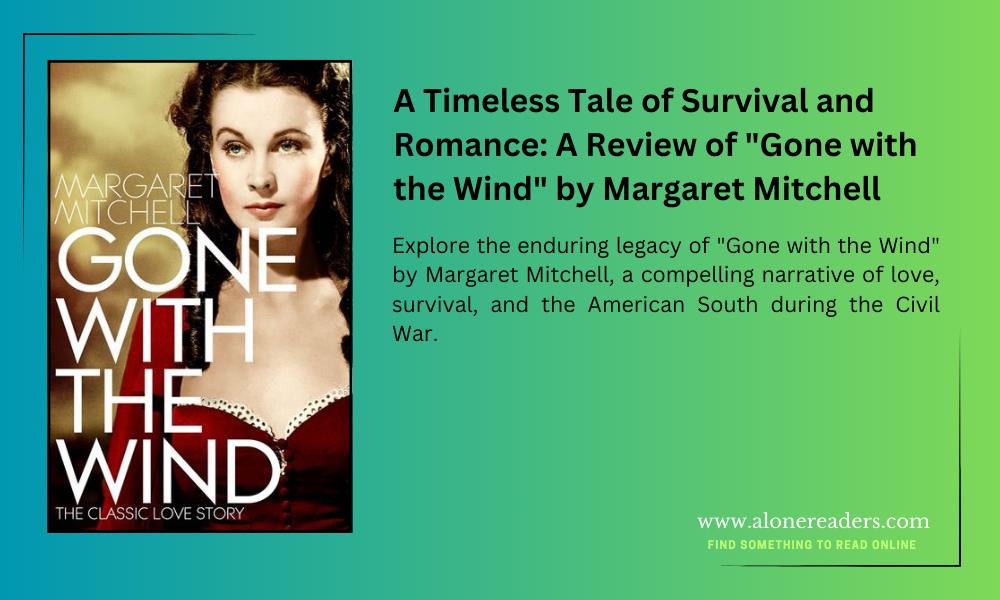
Margaret Mitchell’s "Gone with the Wind" is a monumental work of fiction that has captured the imagination of readers since its publication in 1936. Set against the backdrop of the American Civil War and the Reconstruction era, the novel tells the story of Scarlett O’Hara, a headstrong Southern belle whose life is turned upside down by the tumultuous events of the time. Through Scarlett’s eyes, Mitchell weaves a rich tapestry of love, loss, and survival that continues to resonate with readers more than eighty years after its initial release.
The novel’s central character, Scarlett O’Hara, is one of the most complex and memorable figures in American literature. Mitchell presents her as a woman of contrasts—beautiful and cunning, selfish and resilient, passionate and ruthless. Scarlett’s journey from a pampered daughter of a wealthy plantation owner to a determined survivor who will do anything to protect her home, Tara, is both captivating and unsettling. Her ability to adapt to the changing world around her, often at the expense of her morals and relationships, makes Scarlett a compelling and deeply flawed heroine.
At its core, "Gone with the Wind" is a love story, but it is not a conventional one. The novel explores Scarlett’s tumultuous relationships with three men: the idealistic Ashley Wilkes, the charming and opportunistic Rhett Butler, and her steadfast but overlooked first husband, Charles Hamilton. Scarlett’s unrequited love for Ashley drives much of the plot, but it is her complex and often adversarial relationship with Rhett that provides the novel’s most memorable moments. Mitchell masterfully depicts the push and pull between Scarlett and Rhett, capturing the passion, frustration, and tragedy that define their bond. Their relationship is both a reflection of and a reaction to the war and its aftermath, making it a poignant commentary on the broader societal changes of the time.
In addition to its compelling characters, "Gone with the Wind" is notable for its vivid depiction of the American South during the Civil War and Reconstruction. Mitchell’s portrayal of the South is both nostalgic and critical, offering a romanticized vision of the antebellum era while also acknowledging the harsh realities of slavery and the devastation wrought by the war. The novel’s depiction of the South has been the subject of much debate, with critics pointing to its idealized portrayal of plantation life and its sympathetic treatment of the Confederacy. However, Mitchell’s work also provides a valuable historical perspective, capturing the complexities and contradictions of the time.
One of the novel’s most enduring themes is the idea of survival. Throughout the story, Scarlett embodies the will to survive at all costs, whether it is through her determination to save Tara, her willingness to manipulate those around her, or her unyielding resolve to rise above the hardships of war and Reconstruction. Mitchell’s exploration of survival extends beyond Scarlett, touching on the experiences of other characters who must navigate the challenges of a world turned upside down. The novel’s famous closing line, "Tomorrow is another day," encapsulates this theme, serving as a testament to the resilience of the human spirit.
"Gone with the Wind" is also a deeply emotional novel, filled with moments of triumph and tragedy. Mitchell’s writing is both lush and evocative, drawing readers into the world of the Old South and its inhabitants. The novel’s sweeping narrative and epic scope have made it a classic, but it is the emotional depth of the characters and their struggles that have ensured its place in literary history.
Despite its many strengths, "Gone with the Wind" is not without its flaws. The novel’s portrayal of race and its depiction of African American characters have been the subject of much criticism. Mitchell’s sympathetic portrayal of the Confederacy and her romanticized view of the antebellum South can be difficult for modern readers to reconcile with the historical realities of slavery and racial inequality. These aspects of the novel have sparked important conversations about the way history is remembered and represented in literature.
In conclusion, "Gone with the Wind" is a complex and multifaceted novel that continues to captivate readers with its rich characters, compelling narrative, and exploration of survival in the face of overwhelming odds. While its portrayal of the South and its treatment of race are problematic, the novel remains an important work of American literature, offering a window into a pivotal moment in history. Mitchell’s ability to create a story that is both epic in scope and deeply personal in its exploration of love, loss, and resilience ensures that "Gone with the Wind" will continue to be read and discussed for generations to come.